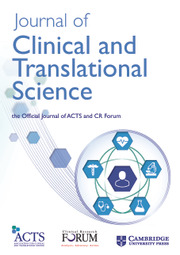No CrossRef data available.
Article contents
201 Neighborhood socioeconomic deprivation is not an independent predictor of cardiovascular reactivity during static exercise in young adults
Published online by Cambridge University Press: 24 April 2023
Abstract
OBJECTIVES/GOALS: Greater blood pressure (BP) reactivity and socioeconomic deprivation (e.g., area deprivation index; ADI) are associated with poor vascular health [1-3]. However, it is unclear if ADI is associated with BP reactivity. Thus, we sought to examine if ADI is associated with BP reactivity in young adults. METHODS/STUDY POPULATION: Participants completed questionnaires used to derive lifetime ADI averaged from early-, mid-childhood, and adolescence. Participants completed a handgrip (HG) exercise protocol including 10 minutes of rest, 2 minutes of static HG at 40% of their maximal voluntary contraction, 3 minutes of post-exercise ischemia (PEI), and 2 minutes of recovery (REC). Beat-to-beat BP (photoplethysmography) and heartrate (HR; electrocardiogram) were continually assessed. We used the Shapiro-Wilk test to assess data for normality. We examined associations between ADI, BP reactivity, and HR using unadjusted and body mass index (BMI), sex, and race-adjusted Pearson’s correlation (set a priori to 0.05). RESULTS/ANTICIPATED RESULTS: This study included 53 (27Males/26Females; 21 ± 1 years; 24Black/29White; BP 107 ± 9/64 ± 9 mmHg) participants. There were racial differences (Black compared to White adults) for several BP reactivity metrics (e.g., PEI minute 3 diastolic BP: 96 ± 15 vs. 84 ± 19 mmHg, p=0.014) and lifetime ADI (p0.050). DISCUSSION/SIGNIFICANCE: Our data suggest racial differences exist in socioeconomic deprivation in a modestly sized young adult sample living in the southeast. While additional data are needed for other stressors, socioeconomic deprivation was not independently associated with BP or HR reactivity during acute exercise.
- Type
- Health Equity and Community Engagement
- Information
- Creative Commons
- This is an Open Access article, distributed under the terms of the Creative Commons Attribution-NonCommercial-NoDerivatives licence (https://creativecommons.org/licenses/by-nc-nd/4.0/), which permits non-commercial re-use, distribution, and reproduction in any medium, provided the original work is unaltered and is properly cited. The written permission of Cambridge University Press must be obtained for commercial re-use or in order to create a derivative work.
- Copyright
- © The Author(s), 2023. The Association for Clinical and Translational Science


